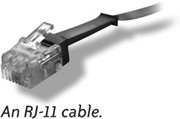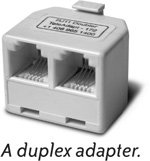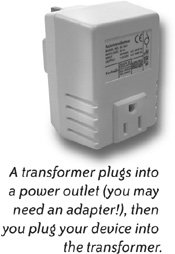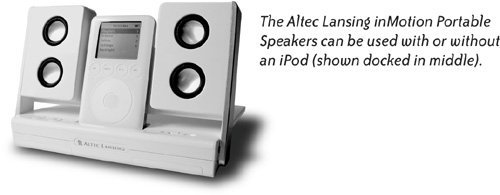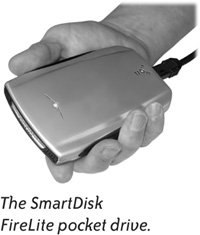Essential Mobile Accessories
| While your Mac laptop and its included software will get you connected and online in most situations, there are some mobile accessories that make mobile computing, both domestic and foreign, easier and less stressful. One small reality check: If you carry all this gear around with you, it means you're pretty much obsessed with this Road Warrior stuff. Your load can be lightened considerably if you eliminate the digital camera equipment from the list (which I personally consider more important than the convenience of traveling light). Laptop Carrying CaseA nice carrying case helps protect your computer and gives you a place to keep most of your accessories together. I prefer a backpack-style computer bag because I usually also carry a camera bag that's large enough to hold a digital video camera and a digital still camera. When I wear the backpack, I still have one hand free to use my mobile phone, my PDA, my GPS, or my iPod. Or to show my ID to airport security agents. Mini MouseA laptop provides a trackpad, so you don't have to use a mouse. But for some of us, a mouse is much easier to use and the trackpad feels awkward. A mini mouse is extra small, lightweight, and packs away nicely. The small footprint of a mini mouse gives more room to maneuver when you're working in a crowded space, such as a cafe table or an airline fold-down tray. Search the Internet for "mini mouse" to find a wide selection of both wired and wireless (Bluetooth) models. Some of our favorites can be found at Targus.com and iogear.com. Don't forget to put a mouse pad in your bag. Spare Cables and Cable AdaptersIt's better to take cables with you and not use them than to need a simple little cable and have to spend hours in an unfamiliar city trying to find one.
Power Supplies
 Do NOT use an external transformer with a Mac laptop because your power cable has a built-in transformer. If you add another transformer, the laptop will ignore the external power supply completely and run on battery power. Thus if you leave your laptop on thinking the battery is being charged because it's plugged into a power supply, you'll discover it is actually draining the battery. Note! A converter is not the same as a transformer. A converter is what you need for electrical (as opposed to electronic) devices that have motors, such as hair dryers, shavers, irons, etc. A converter is meant for short-term use. And it is really heavy to carry around (it can be just as cheap to buy a hair dryer or iron in the country in which you'll be traveling and it will weigh less). Electronic devices like your computer, camera, etc., use transformers, not converters.
AirPort Extreme Base StationThe AirPort Extreme Base Station is not a portable device, but it does make you and your laptop more portable around the home or office."Extreme" means the device is using the 802.11 g wireless standard, which is five times faster than the 802.11 b standard used in the original AirPort Base Stations. The 802.11 g wireless networks are backward-compatible with 802.11 b wireless devices, such as the original AirPort wireless cards, meaning they will work just fine with older devices. To create a wireless Internet connection in your home or office, buy an AirPort Extreme Base Station. Connect your phone line or broadband connection to it with an Ethernet cable. If your laptop has an AirPort Extreme Card installed, you'll be able to connect to the Internet wirelessly as long as you're in range, approximately 150 feet from the base station. If you have an older AirPort card installed in your laptop, it will still work but you'll be limited to transfer speeds of 11 Mbps. AirPort Express Base StationThis device is not essential, but it can add a huge convenience to your mobile life. The AirPort Express is actually a small, portable base station that connects to an existing Internet connection and sends out a wireless signal. You can use it in two ways: to create a new wireless network, or to extend an existing wireless network. Both are explained on the following page. To create a new wireless network: Plug the AirPort Express into a power outlet. Use an Ethernet cable to connect it to your broadband source (a cable or DSL modem) in your home or office or to the broadband data port (an Ethernet port) in your hotel room. Now your laptop can connect wirelessly to the Internet from anywhere in the room. To extend the range of an existing wireless network: Plug the AirPort Express into a power outlet that's within range of the existing network. 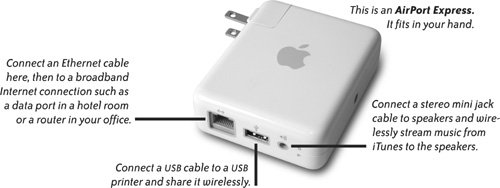 Portable SpeakersThis is certainly something you can leave behind if you want to travel light, but if you have a presentation to give that includes audio, a set of powerful, portable speakers can make a giant difference in the audio quality and impact of the presentation. If you just want to play some songs from your iTunes music collection for a group of friends or show iMovies to relatives, portable speakers enhance the show. Or if you'll be spending a lot of time in that hotel room, bring your speakers; add an AirPort Express (previous page) and stream your music from iTunes to the speakers across the room or have stereo sound for your DVD movie. Just a few of the nifty portable speakers worth checking out are:
Also visit the online Apple Store (http://store.apple.com) to see some of the latest portable speakers: On the Apple Store web page, select "Speakers" from the "iPod Accessories" category, which is (at the moment) on the left side of the web page. The same portable speakers for your laptop will usually connect to an iPod as well, so you can share your iPod music collection with a large group or a small crowd. Or entertain yourself. Portable Storage DevicesIf you plan to do a lot of work while on the go, or if you need to carry more files than your laptop will hold, external portable storage drives are the answer. They're available in all sizes and capacities from many brand-name suppliers. Although you can carry full-sized drives around with you, it's much easier to travel with a miniature drive that's designed for portability. The miniature drives are not only smaller and lighter, they usually don't require their own power supply. Tip Keep a small pack of blank CDs in your laptop case so you can burn backups of important new files. CDs make it easy to share files with someone else. Search the web or one of the many online shopping sites, such as PriceGrabber.com, for "mini drives." You'll find:
In the past we often avoided editing movies during travel simply because digital video requires so much storage space on our laptop. Now we carry a 100 GB pocket drive so we can store imported video externally. In addition, a pocket drive is a fast and convenient backup solution. And it's an easy way to transfer files to someone else's computer. Just connect it to a FireWire-enabled computer and its icon appears on the Desktop. An iPod can also be used as an external hard disk to store and transport files. Connect your iPod. In the iPod preferences in iTunes, check the box to "Enable disk use." Double-click the iPod icon on the Desktop. Drag files or a folder of files from any location on your computer to the iPod window that opens. 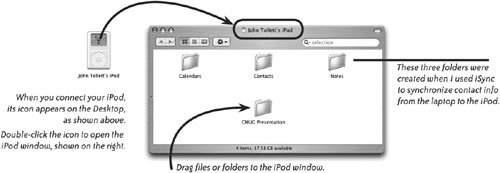 |
EAN: 2147483647
Pages: 119

